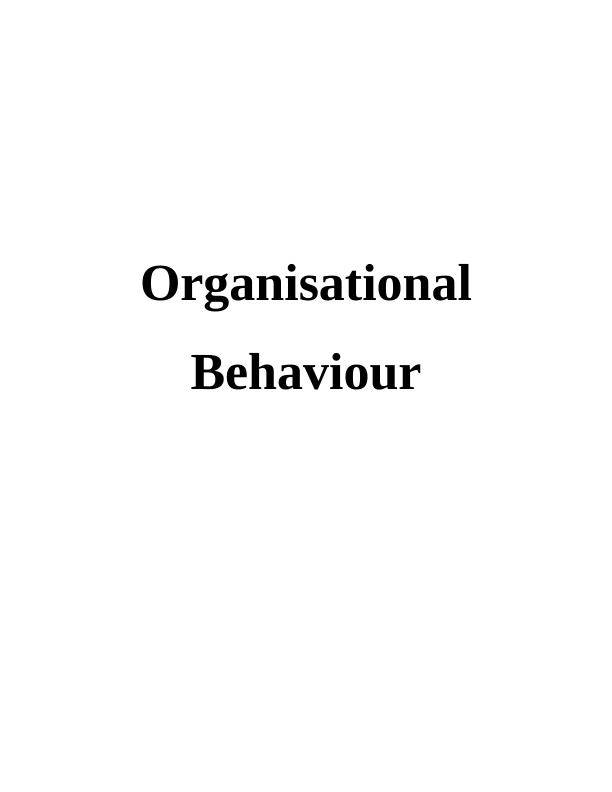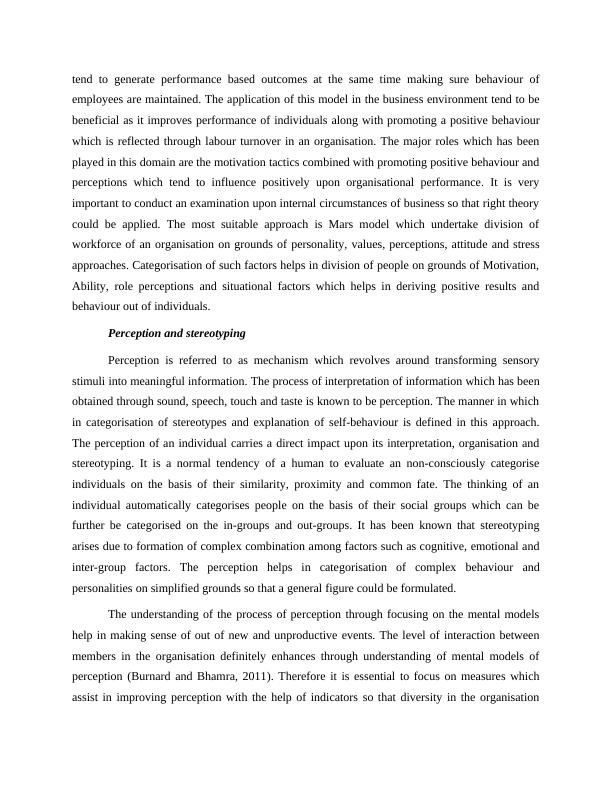Organisational Behaviour Research
7 Pages1875 Words33 Views
Added on 2020-07-22
Organisational Behaviour Research
Added on 2020-07-22
ShareRelated Documents
OrganisationalBehaviour

Topic: “It is better to rely on stereotypes than to enter into a relationship with someone fromanother culture without any idea of what they believe in.”IntroductionOrganisational behaviour is an amalgamation of two terms i.e. organisation andbehaviour. It is defined to be a field of study which examines behaviour of individual withininstitution and identify measures through which it could be influenced positively (Suppiah andSingh Sandhu, 2011). An organisation consists of people belonging to different culture andethnicities work together for a shared purpose which makes it essential for management to takeup measures through which productivity and profitability could be maintained.Individual Behaviour defines manner in which a person reacts to varied circumstances inhis lifetime. The individual behaviour is backed by numerous factors such as personality, values,beliefs and perception which tend to influence his reaction to various circumstance (Dohmen andet. al., 2011). It has been extremely organisation to undertake initiatives which tend to influencebehaviour of an individual in more productive manner. There can be numerous theories whichare undertaken to understand behaviour of a person such as Mars model, MBTI and personalitytraits approach. Stereotyping is an approach in which in which a general set of characteristicsdefines the group to which a person belongs. The major areas which are undertaken in thissimplification are sex, race, age, physical appearance and most importantly religion. There islesser role of experience in stereotyping and mostly relies upon social perception relating to thatgroup. Theories and ModelsThe reason for which stereotyping are perceived better than having no knowledge is thatthey provide familiarity with a person to a marginal extent which is definitely better than notknowing a person at all. The prime theory which has been emphasized is Mars model. Thismodel defines measures through which behaviour of an individual could be influenced within anorganisation. This model emphasizes on personality of individual and its channelising so thatbetter organisational goals are fulfilled. A business consist of numerous people working togetherpossessing distinct behaviour which can be categorised on the performance grounds, citizenship,counter productive and attendance. The categorisation of the employees on the basis of theirtypes of personality through Big 5 personality model. This is most influential approach which

tend to generate performance based outcomes at the same time making sure behaviour ofemployees are maintained. The application of this model in the business environment tend to bebeneficial as it improves performance of individuals along with promoting a positive behaviourwhich is reflected through labour turnover in an organisation. The major roles which has beenplayed in this domain are the motivation tactics combined with promoting positive behaviour andperceptions which tend to influence positively upon organisational performance. It is veryimportant to conduct an examination upon internal circumstances of business so that right theorycould be applied. The most suitable approach is Mars model which undertake division ofworkforce of an organisation on grounds of personality, values, perceptions, attitude and stressapproaches. Categorisation of such factors helps in division of people on grounds of Motivation,Ability, role perceptions and situational factors which helps in deriving positive results andbehaviour out of individuals. Perception and stereotypingPerception is referred to as mechanism which revolves around transforming sensorystimuli into meaningful information. The process of interpretation of information which has beenobtained through sound, speech, touch and taste is known to be perception. The manner in whichin categorisation of stereotypes and explanation of self-behaviour is defined in this approach.The perception of an individual carries a direct impact upon its interpretation, organisation andstereotyping. It is a normal tendency of a human to evaluate an non-consciously categoriseindividuals on the basis of their similarity, proximity and common fate. The thinking of anindividual automatically categorises people on the basis of their social groups which can befurther be categorised on the in-groups and out-groups. It has been known that stereotypingarises due to formation of complex combination among factors such as cognitive, emotional andinter-group factors. The perception helps in categorisation of complex behaviour andpersonalities on simplified grounds so that a general figure could be formulated. The understanding of the process of perception through focusing on the mental modelshelp in making sense of out of new and unproductive events. The level of interaction betweenmembers in the organisation definitely enhances through understanding of mental models ofperception (Burnard and Bhamra, 2011). Therefore it is essential to focus on measures whichassist in improving perception with the help of indicators so that diversity in the organisation

End of preview
Want to access all the pages? Upload your documents or become a member.
Related Documents
Role of Stereotypes in Workplace and Organisational Behaviour Solutionslg...
|7
|2482
|270
Merits and Problems of Stereotyping at Workplacelg...
|7
|2109
|234
Social Psychology: Theories of Stereotyping and Group Formationlg...
|14
|4623
|68
Organisational Behaviour : Doclg...
|7
|2158
|24
Organizational Behaviour: Stereotypes, Theories, and Organizational Issueslg...
|9
|2057
|206
Evaluation and Reflection Assignmentlg...
|14
|4880
|71
